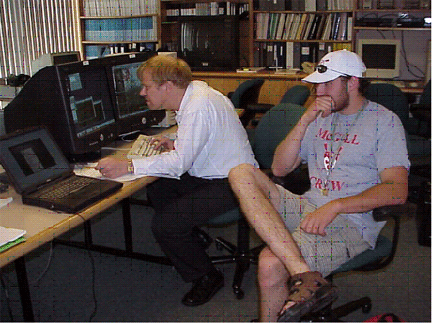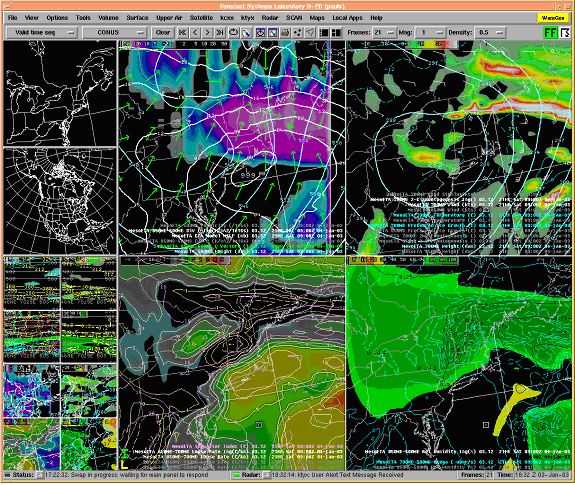
Figure 1. Dr. John Gyakum and Ron McTaggart-Cowan in the
NWS BTV conference room reviewing the 7 January 2002
Storm on the BTV Warning Event Simulator (WES).
SECTION 1: PROJECT OBJECTIVES AND ACCOMPLISHMENTS
The objectives of the project include:
Scientific goals:
To understand the necessary and sufficient conditions associated with significant cold-season precipitation events in the Burlington, Vermont region.
To understand the role of topography in northern Vermont, northern New York and southern Quebec in modulating wind and precipitation fields.
To understand the relationship between the synoptic scale and mesoscale processes in precipitation events.
To examine the predictability of the extreme cold-season precipitation event.
These goals were met with the following completed work (accomplishments are numbered to correspond to each of the above goals:
Dorothy Durnford has successfully
completed Master's thesis entitled "An analysis of Montreal's record-breaking
heavy rainfall event of 8-9 November 1996, and a comparison with its best
analogue", 2001 (115 pages). This study distinguishes the significant
event from its less-significant counterpart by identifying mesoscale cyclogenesis
and frontogenesis as occurring in the record-breaking November 1996. These
processes were absent in the analogue case of 1977.
We have followed up on Dorothy Durnford's Master's thesis entitled "An
analysis of Montreal's record-breaking heavy rainfall event of 8-9 November
1996, and a comparison with its best analogue", 2001 (115 pages), with
a successful mesoscale simulation of this case with the Mesoscale Compressible
community model. These results were presented to the community at the AMS
Conference on Weather Analysis and Forecasting this past August 2002 in San
Antonio, TX. This study distinguishes the significant event from its less-significant
counterpart by identifying mesoscale cyclogenesis and frontogenesis as occurring
in the record-breaking November 1996. These processes were absent in the analogue
case of 1977. We have followed up this work with new simulations using the
MC2 model to test the role of orography on the dynamics of this case. Currently,
we are preparing this work for submission to the Monthly Weather Review.
A manuscript, entitled "Synoptic
and planetary-scale precursors to significant cold-season precipitation events
in Burlington, Vermont (Sisson and Gyakum 2003), has been submitted to the
American Meteorological Society and is in final review for the Weather and
Forecasting journal. We are currently working on the revisions requested by
the Editor, and expect the manuscript to be published in 2004.
The role of orography was investigated through testing of mesoscale models at grid-spacings ranging down to 3 km.
As for #1 above.
The predictability issue is the topic of Dorothy Durnford's Ph. D. dissertation work on the role of upper-level precursors in the predictions of quantitative precipitation for the Saint Lawrence and Champlain Valleys.
Operational forecasting goals:
Educational goals:
further the understanding of NWS forecasters on the extreme cold-season precipitation events in the region through local workshops and local web based training modules.
To further the understanding of NWS forecasters in the topographic variability of wind and precipitation
Accomplishments:
A joint NWS-BTV/ McGill workshop on winter weather was held at the Burlington Forecast office on Wednesday, December 5, 2001. Ron McTaggart-Cowan produced a lecture on potential vorticity concepts. John Gyakum discussed the March 1993 Superstorm, and also gave a laboratory on forecasting heavy wintertime precipitation events.
Availability of testing results of mesoscale modeling is being made to the forecasters.
Planning meetings were held at McGill on 3 July 2001, 24 October 2001, and 23 January 2002, 10 April 2002, 13 Jun 2002, 3 July 2002, 17 July 2002, 16 October 2002, 24 Jan 2003, 7 March 2003, 15 April 2003, 21 June 2003, 23 June 2003. Meetings were held at Burlington WFO on 11 June 2001, 22 August 2001, 5 December 2001.
Jason Neilson, Meteorological Intern, WFO Burlington, completed precipitation type analysis of the moderate and light precipitation cases used in the composite analysis.
Workstation Eta 5-km Mesoscale model was upgraded to Version 2.0 and moved to a dual 1.5GHz Linux workstation. Forecast length increased to 60-h and made available in AWIPS for operational forecasters in real-time.
Paul Sisson developed Advanced Weather Interactive Processing System (AWIPS) procedures developed for use by operational forecasters to view output from the workstation Eta.
Paul Sisson presented an overview of the 7 January 2002 heavy mesoscale banded snowstorm at the 9 January 2002 WFO Burlington Station meeting.
The McGill team has implemented the most recent version (4.9.3) of the Mesoscale Compressible Community Model (MC2) at 3-km resolution for approximately the same domain as being used for the workstation Eta 5-km mesoscale model. The model has been running continuously in real-time since May 21, 2002, each day with a 0000 UTC initialization time, for a 48-h forecast range.
To support the above real-time modeling effort at McGill, we have hired a senior undergraduate student, Sebastien Chouinard, to produce forecast products, and to distribute these to the BTV forecast office.
John Gyakum, Professor Isztar Zawadzki, and McGill graduate student Florence Bocquet, participated in the Warm-season severe weather workshop in Burlington on 15 May 2002. Prof. Zawadzki presented a summary of the operational and research products offered by the Stewart Marshall McGill University Radar Observatory. Florence Bocquet presented her Master’s Thesis research on the relationship between synoptic-scale precursors and the development of mesoscale vortices in the Montreal region.
The combination of real-time modeling efforts that are occurring at both the BTV forecast office and the McGill University are helping to accomplish the scientific, operational forecasting, and educational objectives goals listed above.
A new initiative has begun to
enhance our understanding of heavy precipitation with two case studies. The
abstract of this work, involving operational forecasters from the National
Weather Service and the Meteorological Service of Canada, follows:
This research focuses on
the physical processes relating to two recent events of precipitation in which
at least 25 mm of liquid equivalent precipitation occurred within a 12–h
period. The first event was that of the heavy snow in Albany, New York of
7 January 2002, and the second event was that of a heavy snow in Halifax,
Nova Scotia of 4-5 February 2002. Each event was evidently unrelated to topographic
forcing. Each case was also mostly unforecasted by the operational models
with horizontal resolutions ranging to 6 km. Although each case occurred in
a large-scale flow that was favorable for cyclogenesis, several crucial details
relating to the extreme mesoscale development are identified and studied.
Additionally, cyclogenetic mechanisms are studied.
The mesoscale environment is studied
in the context of both upright and slantwise convection. The processes that
were responsible for this destabilization include upper-level cooling associated
with the advance of an upper-level short-wave trough, and the development
of conditional symmetric instability.
Frontogenetic forcing was especially large in the middle troposphere in each
case. The fact that ascent maxima of –20 to –50 microbars per
second occurred in the vicinity of these zones of frontogenesis suggest the
importance of this forcing contributing to these events’ strength.
Considering that the upper-level
frontogenesis was associated with a sloping dynamic tropopause, we investigate
the role of the diabatically-induced effects of the observed moist convection
in each case. To do this, we use a high-resolution version of the Mesoscale
Compressible Community Model (MC2) with an accurate microphysical parameterization
and explicit representation of cumulus effects. We investigate the hypothesis
that moist upright convection produces a positive feedback on surface cyclogenesis
through the mechanism of diabatically-induced ridging. This ridging shortens
the wavelength, and increases the cyclonic vorticity advection over the developing
cyclone.
We have also produced a credible MC2 simulation of the 7 January 2002 case for Albany, NY. Diagnostic analysis of this case has begun using the MC2 forecast data. The collaborative research on these cases continues. We have followed up on this work by quantitatively assessing the role of water vapour initialization in the MC2 following the technique of McTaggart-Cowan et al. (2003), and have begun to write up this work for publication in the Monthly Weather Review. Presentations of this work are summarized in section 3.
SECTION 2: SUMMARY OF RESEARCH AND EDUCATIONAL EXCHANGES:
Seminars or training workshops conducted by either the university or NWS:
4 December 2001: Meteorological Service of Canada workshop on extreme winter weather, hosted by McGill University. Presentation listed in section 3.
5 December 2001: Joint NWS-BTV/McGill workshop on winter weather was held at the BTV forecast office. Presentations by both McGill and BTV personnel are listed in section 3 below.
17 February through 1 March 2002: John Gyakum was the lead academic instructor for the Winter Weather Course at COMET in Boulder, Colorado for the Meteorological Service of Canada. The enrollment was 20 students, including six from the US National Weather Service.
13 May 2002: Invited presentation to the COMET course in Boulder, Colorado, entitled "East coast cyclogenesis". Duration of 2 hours.
15 May 2002: Joint NWS-BTV/McGill workshop on summer severe weather was held at the BTV forecast office. Presentations by both McGill and BTV personnel are listed in section 3 below.
A joint NWS-BTV/ McGill workshop on winter weather was held at the Burlington Forecast office on Wednesday, November 13, 2002. Ron McTaggart-Cowan produced a lecture on real-time modeling with the MC2 at McGill University. John Gyakum presented a lecture, entitled "Potential vorticity and the dynamic tropopause."
Ron McTaggart-Cowan participated in a forecast shift at WFO BTV on Nov 16, 2002.
29 May 2003: Operational Weather Workshop at the BTV Forecast Office. Both Dr. Gyakum and Mr. McTaggart-Cowan participated in this workshop.
Joint preparation of publications:
Sisson, P. A., and J. R. Gyakum, 2003: Synoptic and planetary-scale precursors to significant cold-season precipitation events in Burlington, Vermont. Wea. Forecasting, submitted.
Sisson, P. A., P. J. Roebber, J. R. Gyakum, 2002: Forecasting for the 1998 Ice Storm. Work in progress.
Participation of students at the forecast office:
McGill graduate students Dorothy Durnford, Florence Bocquet, and Ron McTaggart-Cowan have visited the BTV forecast office several times during the past year for meetings and workshops. Specific formal presentations are listed in the next section.
SECTION 3: PRESENTATIONS AND PUBLICATIONS
John Gyakum:
Ron McTaggart-Cowan:
Dorothy Durnford:
Florence Bocquet:
Paul Sisson (BTV):
Dan St. Jean ( BTV CSTAR participant):
SECTION 4: SUMMARY OF BENEFITS AND PROBLEMS ENCOUNTERED
University Benefits:
NWS Benefits:

Figure 1. Dr. John Gyakum and Ron
McTaggart-Cowan in the
NWS BTV conference room reviewing the 7 January 2002
Storm on the BTV Warning Event Simulator (WES).

Figure 2. AWIPS Plan view 4 panel display from 4 January 2003 integrating the results of the COMET and CSTAR projects into a usable tool for warning and forecast operations at BTV. Upper left panel shows MSL pressure(solid white), 500-hpa heights(solid gray), 850-500 hPa Q-vectors(green arrows), and divergence(negative shaded). The upper right shows 700-hPa heights, winds, temperatures, and 2-d frontogenesis (positive values shaded). The lower left shows 850-500 hPa lapse-rate (positive shaded) and lower right shows 850-500 hPa mean relative humidity(shaded greater than 70 percent), precipitable water(solid black), and 700-500 hPa omega(cyan dashed negative).
References:
Durnford, D., 2001: Master's thesis entitled "An analysis of Montreal's record-breaking heavy rainfall event of 8-9 November 1996, and a comparison with its best analogue". 115 pp.
Gyakum, J. R., and P. J. Roebber, 2001: The 1998 Ice Storm - analysis of a planetary-scale event. Mon. Wea. Rev., 129, 2983-2997.
Gyakum, J. R., P. A. Sisson, R. McTaggart-Cowan, J. Parker, P. Lewis, and G. Toth, 2003: A study of heavy precipitation occurring in continental and marine environments. Work in progress.
McTaggart-Cowan, R., J. R. Gyakum, and M. K. Yau, 2003: Moist component potential vorticity. J. Atmos. Sci., 60, 166-177.
Sisson, P. A., and J. R. Gyakum, 2003: Synoptic and planetary-scale precursors to significant cold-season precipitation events in Burlington, Vermont. Wea. Forecasting, submitted.